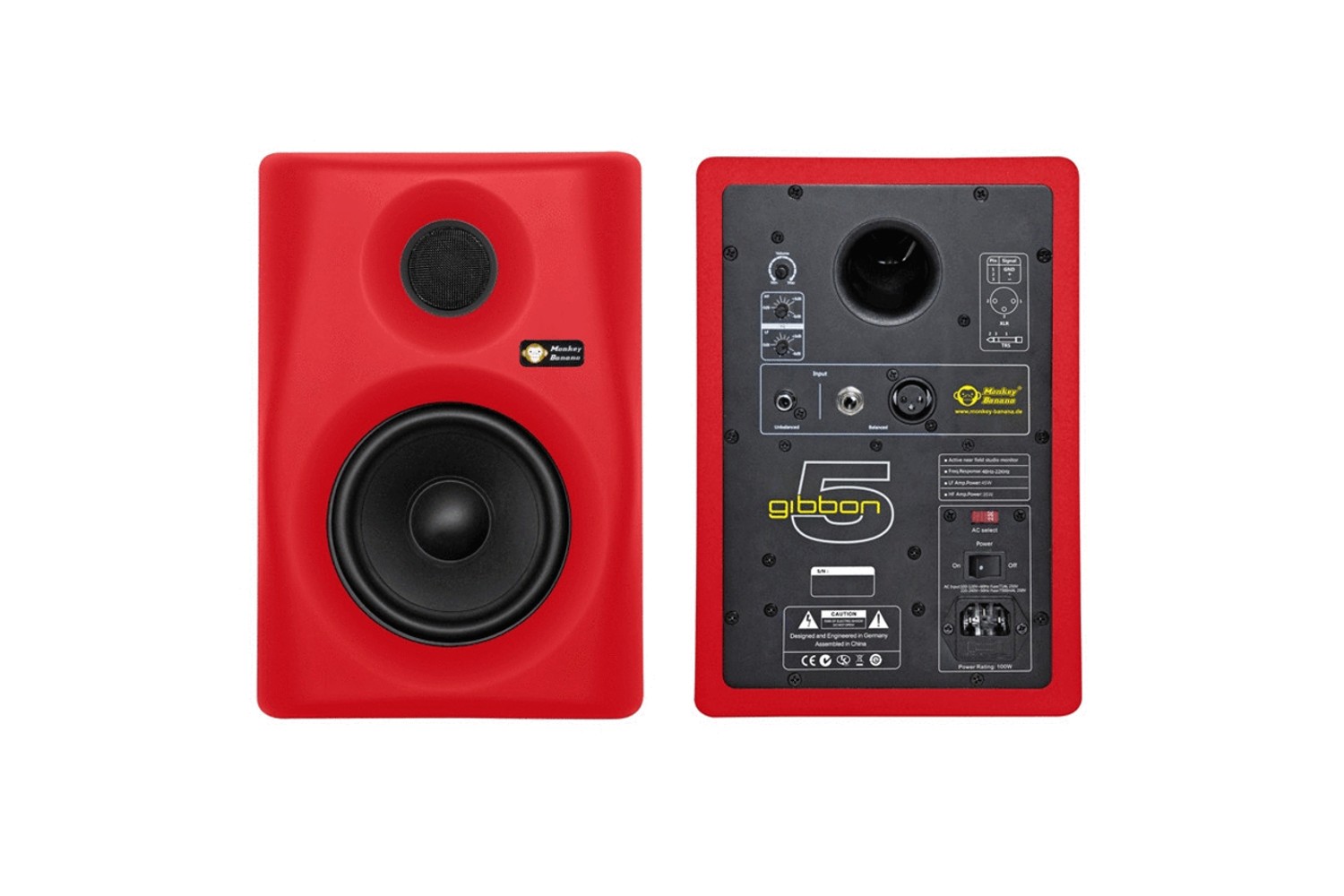Swamp Industries | RRP: A$429.99 (pair)
The market of affordable, quality studio monitors is currently a densely populated space, with every brand seemingly having an entry-level option for the budding audio engineer/musician. Now, enter Monkey Banana into the equation, with their Gibbon range of monitors hitting this price point and quality mark.
The German based audio brand was created in 2004, manufacturing studio monitors for their own studios until they eventually released them to the world in 2010. Of their full range of speakers, the Gibbon series is their entry-level monitor, with 4, 5 and 8 inch versions plus a 10 inch subwoofer.
Catch up on all the latest music gear reviews here.
Gibbon 5’s feature a 5.25” polypropylene diaphragm woofer and 1” silk dome tweeter powered by 45W and 35W of power respectively, courtesy of class A/B amplifiers. The unit features a rear facing bass port and comes in red and black colour options. The monitors have a curved front panel with a Monkey Banana logo that lights up when they’re switched on.
The speakers are capable of reproducing frequencies from 48Hz-22kHz which is substantial for a monitor of this price range. The crossover point between the high and low frequency drivers is set at 3kHz with a signal to noise ratio of 90dB. There’s three input options here, XLR, 1/4 inch and RCA, for flexibility of routing which is pretty standard for this price range of monitors.
Input impedance on the Gibbons is interesting, as the unbalanced impedance is 10 kOhm while the balanced impedance is 20kOhm. This is a great addition to the monitors as it allows for unbalanced connections (from phones for instance) to require less oomf to get the speakers moving, while simultaneously allowing pro audio gear to run through the device without blowing them up on max settings (or near max settings depending on the product).
Pair this with the +4 dBu balanced and -10 dBV unbalanced input sensitivity, and you won’t have to adjust the volume of them between devices. Unlike some other monitors, plugging in an XLR won’t stop the RCA jack from passing audio, which could be useful if you want to have a wired connection and a Bluetooth adapter plugged in simultaneously.
There’s three knobs on the back of the device for adjusting the volume and frequency response of the low and high frequencies. The high shelf kicks in at 10kHz within a range of 6dB above and below the default setting. The low shelf acts within the same range but below 100Hz. The Gibbons don’t feature a high pass filter, but if you’re looking at teaming them up with one of the Monkey Banana Gibbon 10” subwoofers, they have a built-in crossover.
One cool feature on these monitors is they have an auto-off power saving mode aptly named “Jungle Protect” that kicks in after 12 minutes of inactivity. I set these up for a few days whilst testing and found that I could leave them on overnight and when ready come back and start playing music with ease. This makes them a great monitor to have set up all the time, even in home listening environments as you don’t have to worry about them burning through power if you leave them turned on.
During testing I found the centre image to be quite defined, offering a good lens to listen to audio through. Due to the rear facing bass port, the Gibbons can pack quite a punch in the low end, which is great for such a small box. This would suit electronic music producers who are looking for a bit more bottom end in a small space where maybe getting seven or eight inch monitors would be too big for the room.
It should be noted that due to the rear bass port, it’s recommended you place these monitors away from walls by at least the port diameter (in this case about 5 cm) but ideally more to make sure you’re not hearing the reflected sound as much. In testing the clarity was improved moving them 30cm away from the back wall as opposed to the minimum recommended distance of 5 cm.
Using a sine wave generator, the Monkey Banana Gibbons became audible at 35Hz which is lower than advertised, but it wasn’t until 80Hz that the signal turned up to its full capacity. I’d say there’s something under the hood that is suppressing the low-low frequencies (i.e. a high pass filter) on these monitors, which overall is a good thing for longevity and not pushing out lots of muddy low end—which there is sufficient enough of already.
The mid-high frequency response is quite forward on the Gibbons, providing a pretty decent picture of what’s going on. The high frequency response at flat EQ settings was great during low volume playback, but once cranked, I found that I had to turn down the high frequency shelf as it was a bit too much for my taste. Even at these louder playback levels, the highs were reasonably crisp and usable if you like to listen/monitor at loud volumes.
Tested with a vocal track featuring excess sibilance, it was extremely present, which may serve a great purpose when used as a second reference monitor in a professional studio to check translation across devices.
All in all, the Monkey Banana Gibbon 5s are a decent monitor and do a good job for the price range. Having multiple inputs accessible without having to unplug another is great for home users wanting to use them with multiple devices paired with the auto-off function.
As studio monitors they hold their own too, with a solid bass punch and crisp highs to deliver a great performance for their low price. Gibbon 5’s are solid overall, and due to their EQ shelves, can be tuned to your room and listening preferences which will suit a wide range of users.
Check out the Gibbon speakers through their Australian distributor Swamp Industries.

